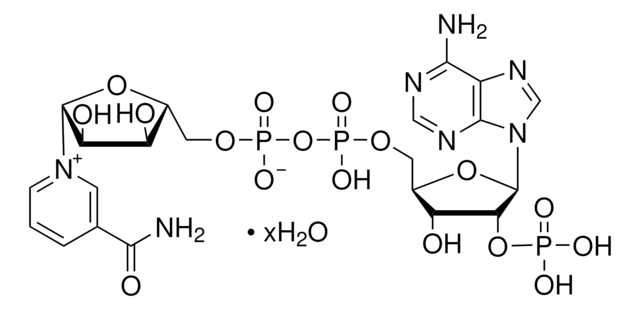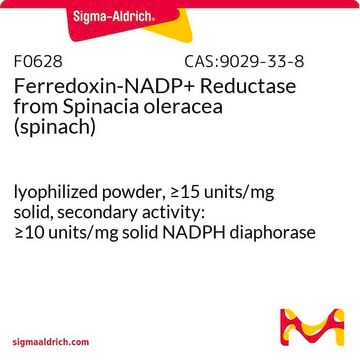19359
Glucose dehydrogenase from Pseudomonas sp.
powder, white, ≥200 U/mg
Synonym(s):
GDH
Sign Into View Organizational & Contract Pricing
All Photos(2)
About This Item
Recommended Products
biological source
bacterial (Pseudomonas spp.)
Quality Level
form
powder
specific activity
≥200 U/mg
greener alternative product characteristics
Waste Prevention
Design for Energy Efficiency
Learn more about the Principles of Green Chemistry.
sustainability
Greener Alternative Product
color
white
greener alternative category
, Enabling
storage temp.
−20°C
General description
We are committed to bringing you Greener Alternative Products, which adhere to one or more of The 12 Principles of Greener Chemistry. This product has been enhanced for energy efficiency and waste prevention when used in biofuel cell research. For more information see the article in biofiles.
Application
Glucose dehydrogenase from Pseudomonas sp. has been used for the oxidation of glucose as a part of flow-injection analysis detection. It has also been used to regenerate the consumed nicotinamide adenine dinucleotide (NADH) during the removal of pyruvate by lactate dehydrogenase.
Biochem/physiol Actions
In bacteria, the membrane integrated glucose dehydrogenase catalyses the conversion of glucose to gluconic acid. It uses pyrroloquinoline quinone as a coenzyme. The intracellular glucose dehydrogenase lack this cofactor. It is a nicotinamide adenine dinucleotide (NADH) dependent enzyme.
Unit Definition
One unit corresponds to the amount of enzyme which will oxidizes 1 μmole β-D-glucose to D-glucono-δ-lactone per minute at pH 8.0 and 37 °C
Storage Class Code
11 - Combustible Solids
WGK
WGK 3
Flash Point(F)
Not applicable
Flash Point(C)
Not applicable
Personal Protective Equipment
dust mask type N95 (US), Eyeshields, Gloves
Certificates of Analysis (COA)
Search for Certificates of Analysis (COA) by entering the products Lot/Batch Number. Lot and Batch Numbers can be found on a product’s label following the words ‘Lot’ or ‘Batch’.
Already Own This Product?
Find documentation for the products that you have recently purchased in the Document Library.
Muhammad Nadeem Zafar et al.
Analytical chemistry, 84(1), 334-341 (2011-11-19)
A new extracellular flavin adenine dinucleotide (FAD)-dependent glucose dehydrogenase from Glomerella cingulata (GcGDH) was electrochemically studied as a recognition element in glucose biosensors. The redox enzyme was recombinantly produced in Pichia pastoris and homogeneously purified, and its glucose-oxidizing properties on
Mátyás Cserháti et al.
Journal of bacteriology, 194(8), 2109-2110 (2012-03-31)
Here we report on the complete genome sequence of Cupriavidus basilensis OR16 NCAIM BO2487. The genome of strain OR16 contains 7,534 putative coding sequences, including a large set of xenobiotics-degrading genes and a unique glucose dehydrogenase gene that is absent
Lu Bai et al.
Talanta, 91, 110-115 (2012-03-01)
An excellent electrochemical sensing platform has been designed by combining the huge specific surface area of carbon nanotubes (CNTs) and the remarkable conductivity of ionic liquid (IL). IL can easily untangle CNTs bundles and disperse CNTs by itself under grinding
Jen-Yuan Wang et al.
Bioresource technology, 116, 502-506 (2012-05-01)
A glucose bio-battery prototype independent of oxygen is proposed based on a glucose dehydrogenase (GDH) bioanode and a graphite cathode with an iodide/tri-iodide redox couple. At the bioanode, a NADH electrocatalyst, poly(methylene blue) (PMB), which can be easily grown on
Kenneth Lan et al.
Journal of diabetes science and technology, 5(5), 1108-1115 (2011-10-27)
A concept for a tear glucose sensor based on amperometric measurement of enzymatic oxidation of glucose was previously presented, using glucose dehydrogenase flavin adenine dinucleotide (GDH-FAD) as the enzyme. Glucose dehydrogenase flavin adenine dinucleotide is further characterized in this article
Our team of scientists has experience in all areas of research including Life Science, Material Science, Chemical Synthesis, Chromatography, Analytical and many others.
Contact Technical Service








